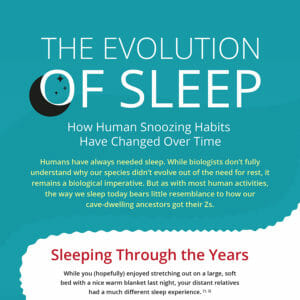The Evolution of Sleep: How Human Snoozing Habits Have Changed Over Time
Humans have always needed sleep. While biologists don’t fully understand why our species didn’t evolve out of the need for rest, it remains a biological imperative. But as with most human activities, the way we sleep today bears little resemblance to how our cave-dwelling ancestors got their Zs. Below we take a brief look at the history of sleep, from prehistory to now.
Sleeping Through the Years – A Short History
While you (hopefully) enjoyed stretching out on a large, soft bed with a nice warm blanket last night, your distant relatives had a much different sleep experience. (1, 2)
Early man
Early humans sleep in ground-based nests of grass and other soft materials stuffed near the walls of caves. Based on small, round shapes of nests, early man likely huddled in fetal positions to sleep.
Human civilization
Ancient Egyptians feared and respected sleep, believing it to be close to death, while Roman bedrooms were small spaces with low ceilings and tiny beds.
Middle Ages
Families often slept together in one big, heat-conserving bed. In Europe, ropes are stretched across bed frames to provide a firm support for mattresses, while in China, bed frames become increasingly ornate with beautifully detailed bedposts.
Industrial revolution
With the proliferation of electric light sources and a shift away from an agrarian economy, people go to sleep later. Private bedrooms become standard for most classes of society.
19th and 20th century
Metal bedsprings become commonplace, and in the later periods, the Murphy bed and waterbed are invented. And near the end of the 20th century, memory foam is invented and becomes affordable enough for average people.
Today
Technology enables sleepers to choose from dozens of mattress sizes and types and to heavily analyze and improve their sleep patterns. But — for most modern Americans, their love of technology also often encroaches upon their sleep.
Then Vs. Now: 200 Years Ago
Here’s a look at how the average American slept two centuries ago compared to how you’re sleeping now.
Then
Beds individually made, no standard size (3)
Double sleep — 8 hours broken into 4-hour periods with a 1- to 2-hour break between chunks (4)
What did people do in their sleep break? They often used the brief waking period to read, visit with neighbors, even have sex. By the 1920s, first and second sleep was a rare practice.
Primitive bedsprings replace ropes or wool straps to support mattresses stuffed with cotton (2)
Spouses often slept in separate beds or rooms (5)
Children most often all slept in one room (5)
Now
Beds in standard sizes with widely available bedding
Technologically advanced beds include memory foam and computerized controls
Single 8- to 10-hour sleeping period
Spouses most often sleep in same bed
Children most often sleep in individual rooms
Why Do We Sleep in the First Place?
Scientists haven’t quite pinned down the biological reasons why we sleep. We know it’s crucial (you’ll die without it), but nobody knows precisely why. (6)
Monophasic vs. Polyphasic
Thought it hasn’t always been this way, almost all humans now engage in monophasic sleep, meaning they sleep in one long chunk.
15%
Mammals with monophasic sleep habits, including humans (7)
What sleep does for us
Sleep serves many biological functions, including: (8)
Learning: The brain consolidates and stores memories and information during sleep.
Creativity: Sleep allows the brain to think harder.
Mood: Chemistry changes post-sleep are similar to taking anti-depressants.
Heart: Sleep allows muscles to rest, improving heart function both short-term and long-term.
Stress: Too little sleep leads to chronic stress.
Immune system: Routine sleep deprivation makes the body susceptible to infection.
Weight: The body produces the hormone leptin, which suppresses the appetite
How much do we need?
Humans have different sleep needs in various stages of life: (7)
Age: Hours recommended
Newborn (0-3 months): 14-17
Infant (4-11 months): 12-15
Toddler (1-2 years): 11-14
Preschool (3-5 years): 10-13
School age (6-13 years): 9-11
Teenager (14-17 years): 8-10
Adult (18-64 years): 7-9
Older adult (65 years+): 7-8
Sleep Around the World
Do your sleep habits match your country of residence?
Sleep and wake time, select countries (9)
U.S. men: 10:55 p.m.-6:40 a.m.
U.S. women: 11 p.m.-6:55 a.m.
Canadian men: 11:05 p.m.-6:45 a.m.
Canadian women: 11 p.m.-7:05 a.m.
UK men: 11:05 p.m.-6:55 a.m.
UK women: 11:05 p.m.-7:30 a.m.
Japanese men: 11:30 p.m.-6:55 a.m.
Japanese women: 11:05 p.m.-7 a.m.
Mexican men: 11:20 p.m.-7 a.m.
Mexican women: 11:40 p.m.-7:55 a.m.
Sleep in Nature
We’re not the only animals that sleep. Here’s a look at sleep in the animal kingdom.
Average hours of sleep per day in the wild (10)
Horse: 3
Elephant: 4
Giraffe: 5
Pig: 8
Sloth: 10
Dog: 11
Cat: 12
Lion: 13
Platypus: 14
Tiger: 16
Armadillo: 18
Brown bat: 20
Take a Nap
We don’t know why we need sleep, but we know it’s good for us. That means naps, too, can make you healthier.
Napping: (11)
Restores alertness
Enhances work performance
Reduces accidents
Types of naps: (11)
Power nap: 10-20 minutes
Siesta: 30-45 minutes
REM: 90 minutes+
Tips for napping: (12)
Watch the time & set an alarm
Find a dark, quiet place; lie down if you can
Coordinate your caffeine
Plan to nap & don’t feel guilty
Additional Resources on Mattress and Sleep Facts
35 Surprising Scientific Facts About Sleep
SOURCES:
1. https://vanwinkles.com
2. https://www.thespruce.com
3. http://www.hudsonvalley.org
4. http://www.bbc.com
5. http://backinmytime.blogspot.com
6. https://www.livescience.com
7. https://sleepfoundation.org
8. https://www.tuck.com
9. http://time.com
10. http://school.sleepeducation.com
11. http://thespiritscience.net

